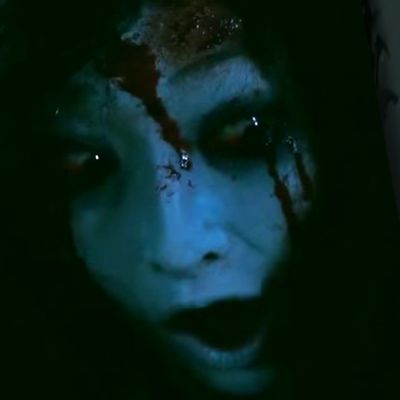
Friday sees the release of Rings, the third installment of a supernatural-horror series first imported to the United States from Japan 15 years ago. The original Ring, director Gore Verbinski’s original take on the popular J-horror film Ringu, raked in hundreds of millions of dollars at the box office, and is truly one of the scariest PG-13 scary movies ever made. Three years later, star Naomi Watts returned for the sequel, which saw original Ringu director Hideo Nakata come on board to direct. The Ring Two seemed teed up for success, but it disappointed both critically and commercially.
So, now we have Rings, the third movie in a series of American J-horror remakes that has seen diminishing returns. You could go see it … or you could watch a much more interesting movie about the same exact subject matter. Two weeks ago, the 2016 movie Sadako vs. Kayako, the culmination of two titanic Japanese franchises, debuted exclusively on the streaming service Shudder, a horror-only digital film library. Boiled down to the most reductive terms, this is J-horror’s Freddy vs. Jason: The movie puts Ringu’s Sadako Yamamura (the character known as Samara in the American versions) against Ju-on’s Kayako Saeki (who gets to keep her name in the American Grudge movies). They’re both demons born of anger and injustice, murdered women whose spirits are doomed to seek vengeance for all eternity. The Ringu and Ju-on cinematic universes previously existed separately, but after a combined 14 movies, the two streams have finally crossed in hopes of bringing to an end the terrifying reigns of both Sadako and Kayako. How? By having them fight to the death, of course. After all, the only thing powerful enough to destroy a curse is another curse.
Is this sequel necessary? Of course it isn’t, and neither is Rings. But, as an American, the film is worth watching for reasons that go beyond cheap screams. As a movie, it’s okay; as a tool for examining a set of foreign myths that have been metastasizing for decades, it’s great. You don’t have to have seen every installment in either franchise to get a lot out of Sadako vs. Kayako, but if you’re curious, here’s the backstory.
The Ju-on film series started in 1998 with two short films from director Takashi Shimizu, Katasumi and 4444444444, in which we meet the franchise’s two key villains: Kayako, and an eminently terrifying little boy named Toshio. From those two shorts sprang the first full-length feature, Ju-on: The Curse, in the year 2000, and the next four years brought Ju-on: The Curse 2, Ju-on: The Grudge, and Ju-on: The Grudge 2. Each movie is comprises short vignettes detailing the fates of those who enter the haunted house that Kayako’s ghost inhabits. After Shimuzu stepped away from the franchise, things got a little more free-form. Ju-on: White Ghost, Ju-on: Black Ghost, Ju-on: The Beginning of the End, and Ju-on: The Final Curse remixed up series’s origin myth, but maintained the same DNA: A person who was heinously dispatched in life becomes a vengeful spirit that will consume anyone who violates their space.
Ringu carved a similar cinematic path. The idea came to life as a book by Koji Suzuki, which was first adapted as a 1995 TV movie called Ring: Kanzenban. Both included a version of Sadako, an evil spirit who lives at the bottom of a well until being unleashed by a cursed video tape, but it wasn’t until three years later, when director Hideo Nakata came along and made Ringu, that we would see the franchise take the shape we know today. Nakata stayed with Ringu through its sequel, Ringu 2, but didn’t direct the prequel, Ringu 0, or either of the more sensational spinoff movies, Sadako 3D and Sadako 2 3D.
What’s most interesting about all these movies, especially compared to their American remakes, is that the communities in which these curses exist have a general understanding of what’s going on. School girls snicker about the cursed tape or the Saeki house, and pass on the oral histories of these urban legends to one another. Adults warn their children not to expose themselves to spiritually toxic elements, lest they invite the curses into their own lives. Priestesses, mediums, and people with extrasensory abilities are regularly consulted for spiritual guidance or protection, and advice from these figures carries grave weight. While the appearances of demons like Sadako and Kayako are certainly not a part of every day life, the fact of their existence is often whispered with reverence, and the stubborn characters who insist on “rational explanations” for the scads of murders taking place around them are the exception, not the rule. Japanese horror has an intimate relationship with myth and spirit, which turns the villains into (relatively) logical extensions of terrible events, instead of just malevolent aberrations.
In Sadako vs. Kayako, the primary antagonists are a pair of university students taking a folklore seminar. We meet them as their professor is explaining the legend of Sadako, which doesn’t give us just a meta-awareness of the story to come, but also means there’s an expert in place for the characters and the audience. Because everything now happens faster than it did in the ‘90s, the number of days you’ve got to live after watching the cursed video has been shortened from seven to two, which speeds up the narrative considerably. The best additions to the story, though, are Keizo, a swaggering priest, and his apprentice, a little blind girl with heightened perception abilities who isn’t about to entertain your disbelief in the spirit realm. She serves as a kind of fourth-wall breaker for people who’ve run the marathon of both franchises. They know the rules, and so does she, and if you aren’t going to let her and her boss do their jobs then you’re welcome to just go off and die.
This little apprentice serves as a direct rebuke to two of the biggest narrative problems in the American Ring and Grudge franchises (and J-horror transplants generally): She establishes the curses as fact, not supposition. Outside of brief introduction to the evil spirits in each movie, audiences here in the States are not invested in the lore behind the villains, and neither are the characters themselves. There’s just no cultural context for them. American characters feel like interlopers in Japanese stories, as each movie has to devote plenty of screen time to explaining the curses over and over again. The protagonists are made to feel like they’re going crazy, because no one has the necessary touch points for what these oppressive forces represent. Those capable of accessing the spirit world are people on the fringe, not to be trusted. In the case of Verbinski’s The Ring, the main character, Aidan, does indeed have the gift of supernatural sight, but he’s basically written as a child with a social disorder.
Inversely, the characters in the Japanese films tend to experience a brief period of shock when first confronted by the curses — a woman crawling out of a TV would surprise anyone — but after the initial trauma subsides, the plot quickly transitions to assessing how to neutralize the evil instead of repeatedly questioning why it exists at all. In the Grudge movies, this can even lead to the tedious problem of Japanese characters having to decode their culture to help the white heroes understand what’s happening. They map out myths and legends and origin stories, only to be told “there must be a better explanation” for their troubles. In third American Grudge movie, the only Japanese character dies as a direct result of a white character’s refusal to believe what she’s seeing — despite the fact that she’s been explicitly told what is happening and how to stop it. It’s almost enough to make you start rooting for Samara and Kayako, just so their targets will finally pay for their adamant refusal to believe their own eyes.
If you watch enough of the Ju-on and Ringu movies, you start to absorb the narrative norms. There is, inevitably, a moment in almost every movie where someone explains why Sadako and Kayako are so damn angry in the first place, but once the references are established, everyone is pretty quick to move on with their lives. The human and spirit worlds live close to one another in Japanese lore, and even if that’s not a native experience for American audiences, immersing yourself in the mythology allows you to have a better cinematic experience: You gain an understanding of the rhythms and tropes, creating a window into the way people across the world interact with the abstract elements of this world and the next. The road to Sadako vs. Kayako may be a long one, and not every stop along the way is a high point in film history, but it’s a whole lot more enriching than watching round three of a borrowed ghost story. Besides, if you’re going to spend your time watching a sequel of a sequel, it might as well be the one culminating in demon-on-demon brawl, with the winner claiming chief soul-taker status. It’s a whole lot more fun, and you might learn something, too.





